White Ethnic Cleansing as Social Control
How social engineers used the Great Migration of Southern blacks to shatter Detroit's Polish community
The author of today’s guest post is Alan Schmidt, who many of you are probably familiar with from the excellent Social Matter. Which, while so far as I know having no direct connection to the sadly departed Social Matter of NRx lore, is an erudite and eclectic blog in the best tradition of the old Social Matter, with recent entries including a deep dive on Wim Hof, the psychic terrorism of crybullies, a meditation on the symbiosis between the rural and the urban, and the absorption of corporate America into the therapeutic state.
The text is entirely Alan’s; my own modest contributions were a few small editorial corrections, along with digging up a smattering of historical pictures with which to illustrate Alan’s narrative. Enough preamble. I’ll pass the mic, and let Alan tell the story of how the Paris of North America turned into, well … the Paris of North America (if you’ve been to Paris recently you’ll get the joke).
By now, we’ve all been inundated with daily stories of illegal migrants and “refugees” being brought from all over the world into small midwestern towns in the dead of night through shady NGOs. The rate of change these communities have seen, their demographics shifting overnight as services are overwhelmed, would seem to be the machinations of a total psychopath with no care for the residents of these towns. No reasonable citizen could watch such a draconian policy of racial replacement of one’s own citizens, while giving away billions of dollars of the citizens’ money to “refugees” for just walking in, as having any motivation other than spite. Hence why migration has been, outside of the brief pandemic debate, the greatest political controversy of the last decade.
This is nothing new. Our government has been involved in such ethnic cleansing programs for a long time, to such a consistent degree that one can argue that internal ethnic cleansing is one of the core tenets of the globe-spanning imperial America that emerged from the American nation-state in the post-WWII world. While the migration of countless incompatible non-Americans into these towns is new, it’s only another crank of the ratchet of a policy that has been continuously implemented for nearly a hundred years. The reality of this has been memory-holed, key histories replaced by narratives that locate the federal government at the moral high ground while denigrating those without a mass propaganda apparatus to defend themselves. This ethnic cleansing has happened in a multitude of cities all across the nation, but for the sake of this story, we will visit Detroit.
The Michigan Department of Transportation is currently executing plans to remove a swath of I-375, a mile wide stretch that the city seized through eminent domain, responsible for destroying thousands of houses in a majority black area. This great sin has been memorialized to this day to the extent that leadership believes that the only way to remove its stain is to remove the highway entirely.
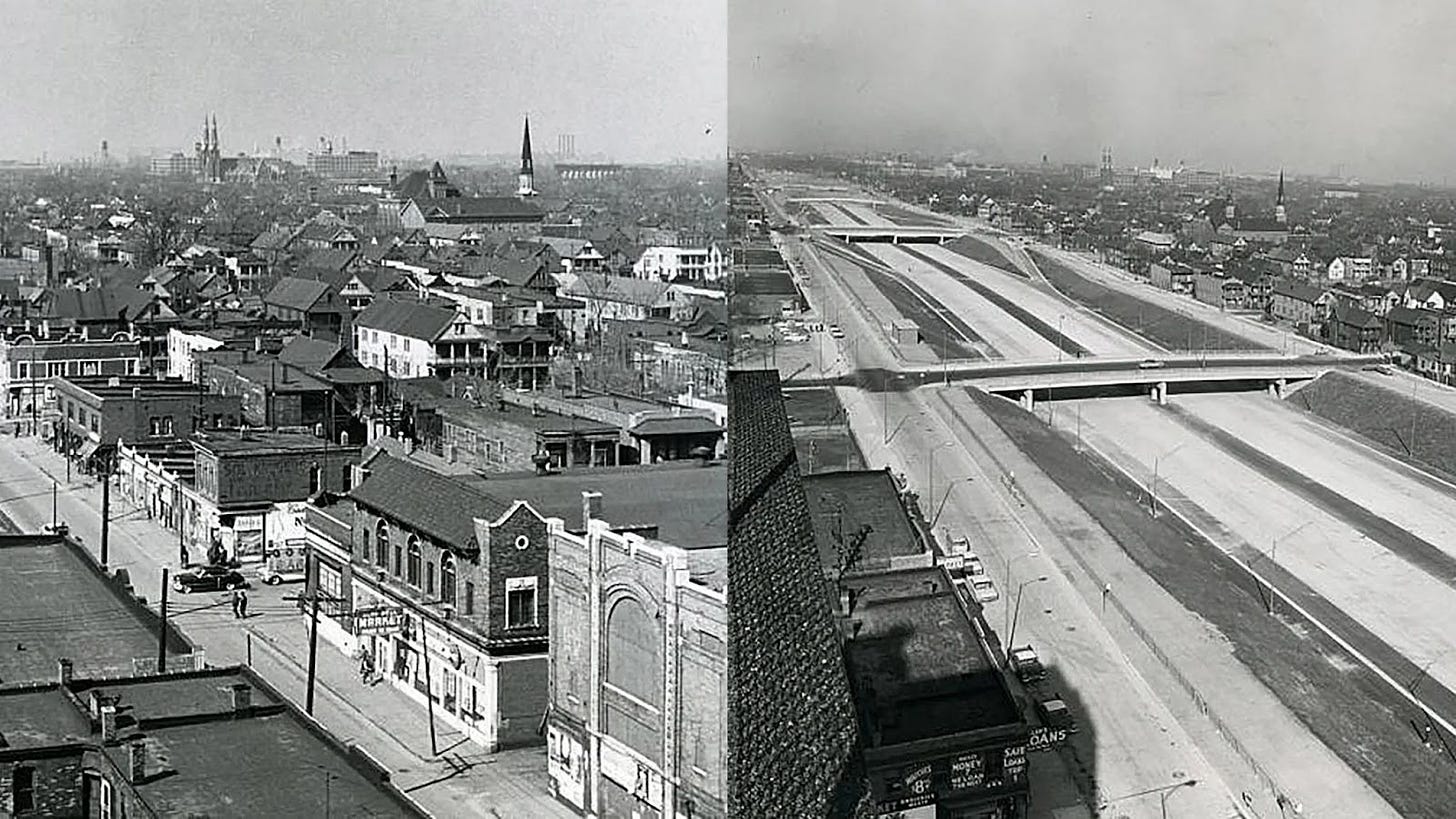
This stretch of I-375 cuts like a gash through the neighborhood, one of the many examples I have seen in communities across the country where a piece of infrastructure has become a barrier,” said U.S. Transportation Secretary Pete Buttigieg. “With these funds, we’re now partnering with the state and the community to transform it into a road that will connect rather than divide.”
Such narratives are a key foundation of the civil rights era, the moral framework of which has supplanted even the founding documents of the country within the hearts of much of America’s population. It’s a story of racist city officials and bigoted residents conspiring against up-and-coming black communities and keeping them down. We are propagandized that Whites relied on zoning, intimidation, and economic inequality to keep minorities in line. It’s been pounded into our minds in every school with pictures of whites surrounding homes in neighborhoods being integrated with blacks, with the narrative that their ignorance and prejudice attempted to reserve civil rights and prosperity for only whites.
While blacks have their share of grievances, there’s another story that isn’t told. It’s the story of a government obsessed with social engineering that saw ethnic enclaves as parallel societies, and therefore as threats to their power. It’s the story of the hubris of city planners who tried to pin their mistakes on the stable Polish communities that lived in the city. It’s a story of a people destroyed, and then, as an insult added to injury, being made the villains. In light of the recent flurry of renewed interest in questions about the WWII narrative, it’s time we took a deep look at the sacred cows of the civil rights era. We will see that the current Great Replacement is as American as apple pie.
Most of this article’s quotes are taken from E. Micheal Jones’ excellent “The Slaughter of Cities: Urban Renewal as Ethnic Cleansing”. The quotes are from that book unless specified otherwise.
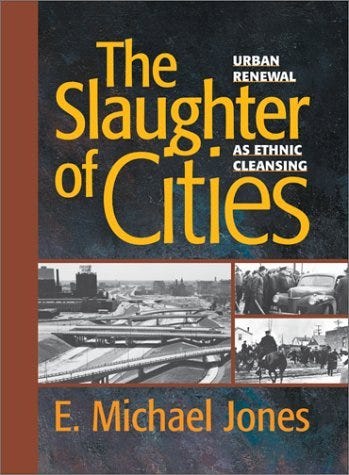
In the early 1920s, after a rash of political violence from anarchist foreigners entering the country, congress wrote legislation to shut off most immigration for forty years. In the time before that, a huge influx of Poles, Germans, Italians, and others had come in such numbers that they formed ethnic communities for themselves in many cities. One of these enclaves was the Poles in Detroit.
The Poles may have been farmers in Europe, but when they came to America, they became factory workers in the great industrial enterprises in America’s industrial cities. Given the working conditions they found here, it was natural that they would become part of the workers’ movement to unionize. The Poles had a natural advantage when it came to organizing for union activity because they were already organized as an ethnic and religious group.
…..
Polish political power is also magnified by the other factors associated with urban living. Since the Poles and other Catholic immigrants live mainly in cities, they are more densely settled than their rural Protestant counterparts and, therefore, more politically powerful than their relatively low numbers would suggest.
Because of their tight-knit community, the Poles were largely impervious to the new mediums of mass propaganda at the disposal of the government. Their ethnic cohesiveness made them capable of punching way above their weight politically. As a result they were a thorn in the side of the automobile manufacturers, and wielded a large amount of clout in the city government.
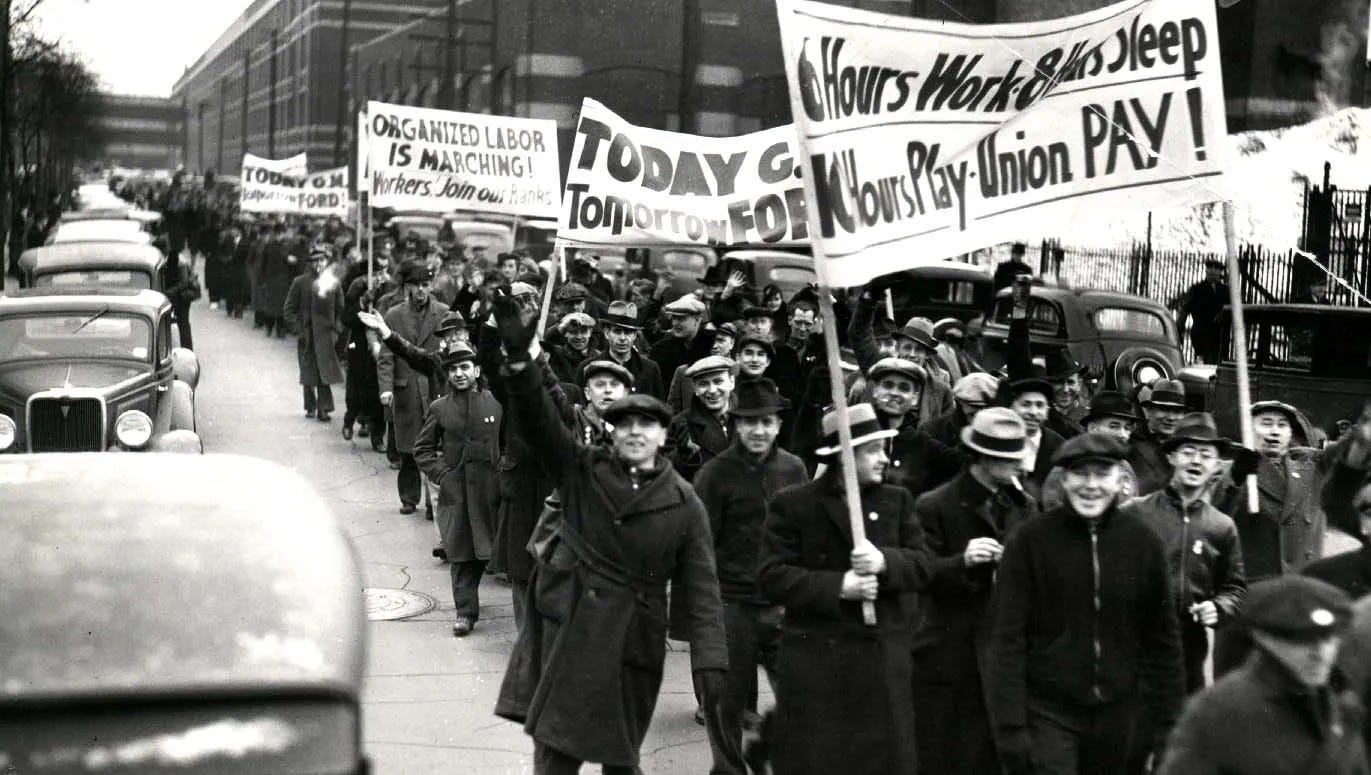
When World War 2 broke out, the desperate need for labor saw a massive rise in blacks coming from the rural south for work. This was looked at with relief by the factories, who saw the black newcomers as much more pliable workers than the truculent Poles.
On the other side of the struggle, industrialists like Henry Ford were bitterly anti-union and made a practice of playing one ethnic group against the other in keeping the workers under control and wages low. One of the groups which Ford favored the most was southern blacks because of their docility and because they were willing to accept the jobs brokered by black ministers in Detroit on the conditions under which they were offered, namely, refusal to join unions.
This is a common tactic. In our own era Jeff Bezos has adopted the same tactic of pitting ethnic groups against one another in order to preclude effective labor organizing.
The blacks coming from the south were cheaper and less organized, but at the price of social dysfunction they brought with them. This should ring a bell: it is hardly the first time corporations have engineered a situation in which they increased their profits via practices which result in ‘negative externalities’ that everyone else has to suffer through.
Washington D.C. was also well aware of the difficulty in controlling these ethnic European enclaves. Many spoke a foreign language, and as a result were largely impervious to infiltration. In 1937, the New Deal “Federal Housing Association” was created to give grants to cities to repair “slums” and “benighted” areas of the city. The implicit goal, however, was to use this money for social engineering by breaking up these tight-knit communities and integrating them into general American society. The Poles, however, had a different value system than what the American elite offered.
According to the middle-class understanding of housing then being promoted by the FHA and other government agencies, one house was just a stepping-stone to a better house. By denying blacks access to their neighborhood, the Poles were denying them opportunity for advancement and full participation in American life. Poles, on the other hand, generally preferred community over advancement.
Detroit, needing further development, took the FHA money and started plans for the “Sojourner Truth” projects, named after a radical feminist and abolitionist. Instead of the plot of land the city planners recommended, the federal overseers decided to place it right next to the Polish community. This was the first attempt to use urban renewal as cover for the dismantlement of the tight-knit Polish community as a precursor to absorption into the white mainstream. The pastor of the Polish community, Reverend Dzink, pleaded with the urban planners, expressing the solidarity his parishioners derived from their own school, customs, and community organization, and the inevitable disruption that the introduction of blacks would cause. Using language not used in good company anymore, he argued that the safe, cohesive community would be wrecked with the influx of crime and deterioration blacks would bring with them.'
As the first tenants of the new federal housing projects moved in under armed watch, the Poles, seeing the encroachment as a form of biological warfare against their community, fought back.
On Saturday, February 28 [1942], Edgecomb arrived at the Sojourner Truth Homes with a contingent of policemen accompanied by the first black families to be moved into the homes, only to be confronted by a group of protesters who barred their way. As that confrontation stood at impasse, other protesters drove through the neighborhood beeping their horns and announcing from a sound truck that the long-awaited move-in was about to take place. When the police commissioner finally got to the site, the crowd had swelled to between two and three hundred supporters, necessitating a call for police reinforcements. The police, however, seemed to sympathize more with the protesters than the people they were called to assist. A black mob in support of the move-in soon formed as well, and verbal altercations escalated to the point where the black mob drove the white mob three blocks down the street, whereupon the white mob, supported by police reinforcements, drove the black mob back again. Sensing that the move-in might lead to bloodshed “and possible death,” Edgecomb called it off, but by then the mob had grown to 1000 people divided along racial lines facing each other angrily at Nevada and Ryan Avenues.
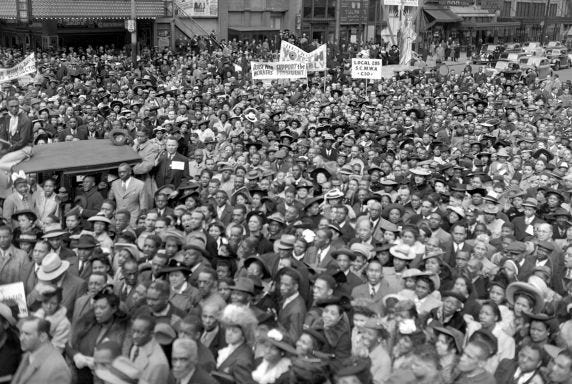
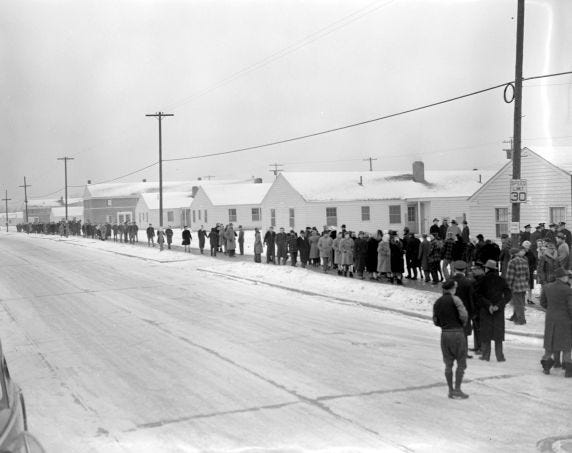
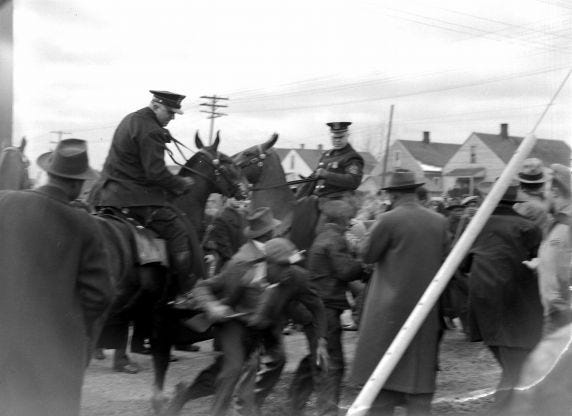
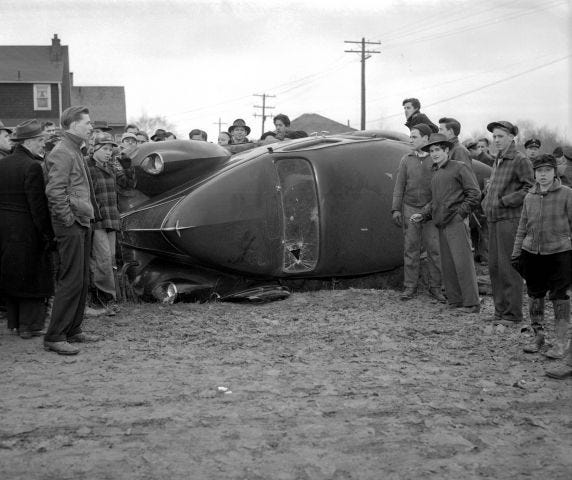
Law enforcement was sympathetic to the Poles, as the cops understood that Rev. Dzink’s predictions about the consequences for Detroit’s Polish community regarding a neighboring black ghetto were accurate. Since the city police refused to do as the feds wished, however, the state government stepped in to flex its muscles.
Shortly after midnight on April 28, two battalions of state troopers occupied the Sojourner Truth project, while other units secured the surrounding area. Over the next three weeks, 168 black families moved into the project under their watchful eyes. Confronted with overwhelming military force, resistance to black occupancy collapsed. Aiding that collapse was the infiltration of the community by undercover agents.
………
It was a civics lesson which cities across the northern tier of the country would all learn in similar fashion. Dzink and his Polish supporters had, in good American fashion, convinced their elected representatives of the justice of their cause, only to have the federal government countermand their efforts with a combination of black intelligence operations directed against American citizens and overwhelming military force. The government’s actions in the Sojourner Truth case would also establish a precedent in both housing and racial matters for the post-war period. Whenever blacks claimed discrimination, they could be sure of the federal government’s concern. Whenever the Catholic ethnics would claim that their neighborhoods were being targeted for destruction, they were written off as racists suffering from paranoid delusion. No matter how much clout the ethnics could muster locally, it could always be countered by some judge, appealing to higher moral principles.
In 1943, a very short time after the Sojourner Truth incident, the Poles would also see the power of propaganda in relaying the approved message to the masses.
June 20, 1943, on a hot Sunday afternoon, a group of blacks led by a newly arrived migrant from Brookhaven, Mississippi, began assaulting whites who had gone to Belle Isle in the middle of the Detroit River for a Sunday picnic. Stealing the white families’ food and overturning their picnic tables, the black mob eventually created an equally violent reaction on the part of the city’s white residents, one that was led by the large numbers of men in uniform from the city. Before nightfall on June 20, some fifty white sailors organized a counter-attack that clashed with the black mob on the bridge leading to Belle Isle. Before long, rumors were circulating through the black community that whites had thrown a pregnant black woman into the Detroit River, and that drove more blacks into the streets looking to avenge an action which had never occurred.
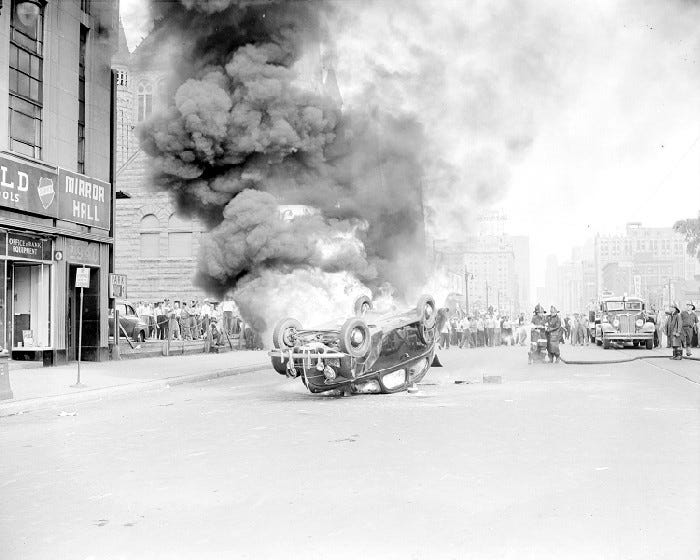
While everything pointed towards the blacks starting the incident, the blame in elite circles was still directed at the Poles, explaining that white racism was the actual cause of the riot. This should also ring a bell in modern times. The Poles were seeing the ground move out from under them with new, hostile, and powerful players. There would be relative harmony for a while after this incident, but it would not last.
After the Sojourner Truth disaster, local authorities were much more careful with federal money, and city councils pushed back against blatant attempts at social engineering. However, as WWII ended, the consensus of Washington D.C. became more and more radicalized in favor of racial integration. Much of this was a reaction to its victory over Nazi Germany, and the resultant need to prove America’s pluralistic bona-fides in opposition to the defeated, racist enemy. The post-war consensus was that we needed to prove to ourselves and the world that we were better than the Nazis we defeated, and were consequently not only militarily destined but morally justified in taking on the mantle of the post-war world’s leadership. The 1944 book The American Dilemma, cited in the landmark Supreme Court case Brown vs. Board of Education, explicitly said this:
The immediate impetus for social engineering was brought on by the war with fascism and enabled by the defeat of the isolationists, whose policy was based on outmoded ideas of race. But its effects will continue after the war. In fact, the main thrust of it will take place after the war. Americans, so the Swede Myrdal warns, better get used to social engineering. The race issue is, in this regard, the thin end of a very large wedge that will soon have enormous repercussions on where people would live and where their children would go to school. America, according to Myrdal, needs to solve its race problem before it can assume its role as leader of the coalition against fascism and then leader of the new internationalist world order following fascism’s defeat.
To succeed, the government needed drastically upgraded powers to allow the social engineering necessary to transform the old, flawed, racist nation into its new, progressive form. Luckily for them, three stunning court cases within years of each other gave them the tools necessary to facilitate their social engineering project.
Can you guess what the court cases were? I’ll bet you know at least one of them. As you’re pondering that, here’s something else to think about: while the main purpose of inviting guest authors to Barsoom is to help them grow their audiences - meaning, you should go subscribe to Social Matter if you haven’t already - it’s not like this is zero effort on my end. These pieces usually go through a few iterations as I help the author polish the text, which takes time and mental energy … time that I’m not using to write my own stuff. To make it worse, I’ve noticed a definite trend in which I often lose subscribers with every guest post. Can you believe it? Horrible, I know.
The point is (and you knew this was coming), if you enjoy these guest posts, you can make your appreciation known by signing up to become a supporter
It isn’t mandatory. There’s no paywall. You can keep reading for free, if you want. Just saying.
The first domino fell with Shelley vs. Kraemer. This case pertained to an African American who bought a home that was restricted by a racial covenant. A neighbor challenged the purchase and the case went to the Supreme Court, which unanimously ruled that racial covenants were unconstitutional. While they limited the ruling by finding that two parties could have such a covenant, it could not be enforced by the court, as in their minds it violated the 14th Amendment.
The 14th Amendment’s main text declares “No State shall make or enforce any law which shall abridge the privileges or immunities of citizens of the United States; nor shall any State deprive any person of life, liberty, or property, without due process of law; nor deny to any person within its jurisdiction the equal protection of the laws.” Its original purpose was to grant citizenship and legal protection to blacks, but as time passed, the ambiguity of the law made it a playground for activist judges to make judgements based on sketchy legal precedents. For those of you who believe 14th Amendment arguments now essentially boil down to “because we want to”, you are correct. With Shelley vs. Kramer, the covenants designed to maintain a community for a certain ethnicity were rendered toothless.
The next domino was Berman vs. Parker, which gave a shocking amount of power to the government to enforce eminent domain. This was based on a very similar condition in Washington D.C. to that of the city of Detroit, in which D.C. wanted to renovate vast swaths of land in blighted areas. The cities, in the name of renewal, would use this to radically transform their urban landscapes. In Detroit, this resulted time and time again in disastrous consequences.
Berman vs. Parker turned on the objection of a department store owner that his specific property was not itself blighted, and that for the government to deprive him of it and hand over the land to a private developer would constitute a violation of the 5th Amendment’s ‘taking clause’, which states “nor shall private property be taken for public use, without just compensation.” The Supreme Court decided unanimously in favor of the government.
The final and largest domino was Brown v. Board of Education. This ruling banned racial segregation in schools, even if the schools were equivalent in quality (the previous standard established in the 1896 case Plessy vs. Ferguson, and the origin of the much-maligned ‘separate but equal’ policy). This opened the gates for the subsequent radical bussing rulings that largely destroyed the ability of local communities to control who enters their schools. The radical bussing policy put blacks in largely white schools, and whites in largely black schools. This was justified on the basis that once blacks had access to the same schools as whites, the academic disparity between the two would end, an idea that was proven to be false. Schools just got worse, and whites began their flight to the suburbs. To this day, everyone knows what people mean when they’re looking for a house and asking if it is in a “good school district”.
The ideal that government leadership publicly said they aspired to, namely racial and ethnic harmony, was a red herring. What they really intended was to deracinate the American population, turning it into a people defined not by culture, race, or religion, but by money.
As part of this undeclared war on ethnicity, Wirth goes on to propose the paradigm of change that will become normative in the period following the war, namely, “the shift from a caste-like relationship to a class relationship.” The solution, in other words, to the threat ethnic communities posed was to break them up by inducing in them a desire to move up the economic ladder into the middle-class, where the organs of the dominant culture — public education, advertising, and the mass media — and not foreign-language newspapers and customs associated with religion and family and country of origin determined the group’s norms…. In other words the notion of class is more congenial to social engineering because it is easier to manipulate according to economic force and mass-media propaganda techniques.
The fact that the post-civil rights environment is largely defined by communities based on money is a feature of the new regime, not a bug. The popular meme that people try to earn enough money to escape the consequences of the civil rights movement is a core pillar of the new order.
The new anti-racist ideology also increased in its soft power, as several non-governmental organizations that were completely aligned with the goals of Washington D.C. began operations. Groups like the Quakers, the Catholic Interracial Council, and philanthropic powerhouse the Ford Foundation used their influence to force racial integration on stubborn communities that refused it. The Church hierarchy, once stalwart supporters of the Catholic ethnic communities, shifted allegiances. During this time in the late 1950s, the moralistic propaganda reaching the masses also increased in volume and intensity, making the Poles feel like they were alone in a fight for survival against everyone. This was by design, as it created a framework where their community leaders were deprived of the moral high ground necessary to make their case for maintaining the ethnic identities of their Polish communities.
The same racial fictions would pervade the nation’s housing conflicts for the next thirty years, creating a no-win situation for the ethnics. When ethnics considered themselves Poles, Italians, etc., they were berated as being un-American and a potential fifth column. When they adopted the American racial paradigm and considered themselves “white,” however, they were condemned as racists. It was in the interest of the WASP ruling-class elite to portray the ethnic conflicts their federal policies created as racial, because in doing so the real purpose of the programs became invisible to the naked political eye, allowing the WASP elite to pursue a campaign of ethnic cleansing and social engineering under the cover of altruism.
As the 1950s passed, tension was slowly but surely bubbling. Urban planners were busy with urban renewal projects, tearing down old houses in crime-laden slums - largely in black areas - with the promise that the new housing would reduce crime. The urban engineers were operating according to the environmental theory that the slums themselves were causing the crime, and therefore once the urban renovation and beautification occurred, crime would decrease.
Unfortunately, the urban renewal projects destroyed far more homes than they built, making the already cramped arrangements worse. While the black slums were not well-functioning communities, they still managed their own sort of stability, and the mass social engineering that destroyed and remade parts of the city caused a massive displacement of the native blacks and brewing resentment. Simply put, the urban planners tried to revitalize black neighborhoods to reduce crime and ended up just making things worse. Even as obvious evidence of the policy’s failure piled up, the renewal efforts continued. There was no room for admitting their policies weren’t fulfilling their promises, and so they developed a scapegoat for their failures: the white ethnic communities.
As the recent strike-down of racial covenants forced neighborhoods to sell homes to anyone, neighborhoods had no legal recourse to keep their homes of a certain ethnicity. As the number of homes sold to blacks increased, it often started a rush of ethnic whites selling their homes and fleeing, fearing more and more blacks would come in, crime and dysfunction would get out of control, and the community would be destroyed. And they were right. This then led to the practice of blockbusting, in which realtors would deliberately sell homes to blacks in order to precipitate white flight, swooping in to scoop up entire neighborhoods at a steep discount as property values crashed. The net effect of this was to strip white communities - the Polish enclave in Detroit among them - of their primary store of wealth.
Anti-racism percolated down to law-enforcement, and the police force underwent a dramatic change. In 1961, George Edwards was made Detroit’s police commissioner. He was a proponent of the new progressive way of thinking, believing one’s surroundings caused criminality. With Detroit, there was some truth to this, as much of the crime was done by people who were displaced by the disastrous urban renewal projects of the city. The police officers on the ground did not respect him, as they felt his policies were way too lax on the black population. Crime increased dramatically, and Edwards’ softer approach, instead of creating a more respectful, peaceful atmosphere, created an environment where violence would soon spiral completely out of control.
Shortly after all of the liberal and black kudos following Edwards’s appointment died down, a morale crisis began to emerge in the police department. The issue was black crime and how to deal with it. Shortly after Cavanagh took office, crime increased dramatically in the city. Just as dramatic was the connection between crime and the city’s black precincts. The statistics were clear. Blacks comprised 29 percent of the city’s population but accounted for 65 percent of the arrests. The city’s highest crime rates were in the neighborhoods with the largest percentage of the black population. And all of those statistics took a dramatic increase after Edwards became police commissioner.
In 1963, Martin Luther King marched in Detroit, expressing the need for blacks to enter the majority white ethnic neighborhoods in the name of justice. This, alongside constant banging on the drums of injustice from NGO’s, was feeding a stewing resentment within the black underclass. Things were reaching a tipping point, and the police were continuing to lose control of several areas because Edwards could not comprehend any reason other than environmental circumstances for black crime, leaving police feeling abandoned on their beats and hopeless against the onslaught.
Officers in the equally beleaguered 16th Precinct convinced one newspaper reporter “that they feel their hands are tied, that they cannot make a legitimate arrest without subjecting themselves to physical injury or a lawsuit and that their morale is shot.
The degradation of law enforcement actually increased aggression in the black community, as criminals smelled blood in the water. They realized the usual institutions were unable to defend the public against mass violent action. This culminated in the famous Detroit riots.
In 1967, police raided an illegal drinking house called “The Blind Pig”, and the resulting riot ended with over 1000 people injured and 400 buildings destroyed. This was the final straw for the local whites, who followed the first waves of refugees into the suburbs. It was clear which side the power structure of the city was on, and it was equally clear that the city was no longer capable of keeping order and protecting its inhabitants.
It ended along with any sense of optimism the nation might have had in solving the race problem. In its place, panic followed. The flow of white residents out of the city and into the suburbs increased to a hemorrhage in the wake of the riot. From 1964 to 1966, an average of 22,000 whites left the city each year. That figure jumped to 47,000 in 1967 and jumped again to 80,000 in 1968. The net result of King’s Freedom March in 1963 was the creation of the nation’s most “segregated” city three decades later. That “segregation” was not based on laws but rather on the fears of whites who felt they were defenseless in the face of an increasingly lawless black population.
With the mass exodus of the remaining whites, the houses of the old ethnic neighborhoods were quickly sold to blacks, and the Poles who ran to suburbia developed a new identity.
In short, “suburbanization and decentralization shifted the traditional, ethnic, blue collar labor force out of the older central cities and built up suburbs and new metropolitan areas” where they were no longer identifiably ethnic. What the ethnics who followed the jobs to the suburbs gained in individual buying power, they lost in traditional political power by being dispersed according to class rather than concentrated according to ethnicity.
By the time the 1970s rolled around, the natural defenses the ethnic groups once possessed were destroyed, and the social engineers ran roughshod over the rapidly deteriorating city. Because of white flight, the demographics of the old neighborhoods changed rapidly. Crime was rampant, and the ethnic groups who held on in the now mixed-race neighborhoods did so from stubbornness or because they couldn’t afford anything else. The attacks on these neighborhoods, however, continued unabated. Neighboring town Hamtramck held on to its core Polish identity for a while longer but was accused of intentionally suppressing blacks trying to enter the neighborhood from renting or buying homes. They were ordered to construct low-income housing for blacks in restitution. The courts, the government, and increasingly public opinion considered the ethnics irrational racists. The social engineers had won the war for integration; all that was left to do was a ruthless mopping-up operation.
In 1974 the Supreme Court forced bussing in an attempt to integrate schools. As Brown vs. Board of Education had failed to close the racial gap and bring racial harmony, the court doubled down with a disastrous edict to force more integration. This attempt didn’t work either: black academic performance continued to lag, and whites continued their flight to the suburbs.
In the same year Coleman Young, a black man with a visceral hatred of Whites, was elected mayor. He would remain in office for twenty years, presiding over Detroit’s precipitous decline. Young wore his prejudices on his sleeve, and did everything he could to incentivize the remaining whites in the city to flee.
In the 1980’s, as a final nail in the coffin of old Detroit, Young used eminent domain to take the remnants of what was left in Poletown, and razed hundreds of homes in the neighborhood for a new auto plant. The plant demolition crew also destroyed the beloved Immaculate Conception Church, evicting a wailing woman who chained herself in its interior.
The irony is deep, since this is the one area that, while not exactly a pleasant neighborhood, came the closest to the integration that the city was aiming for. It was the home of blacks, Ukrainians, Irish, Mexicans, and about everyone else during this time. There was also a large contingent of Poles who stayed behind, and it wouldn’t be out of line to consider whether Young chose the location as revenge.
The story of Detroit was a tragedy for the ethnic communities who lived there, who saw the neighborhoods they grew up in get overrun and burned to the ground. For the blacks who kept control of the city, all that was left was infrastructure they no longer had the finances to maintain, and a social order that saw for many years the most murders in the country. For the locals, social engineering and attempts at integration ended in disaster.
For the country’s elites, however, it could not have been more successful. Not only did they now have a permanent dependent voting block in the black residents of Detroit, but they successfully eliminated a local power center and turned the European ethnics into generic Americans, with the same class consciousness and cultural outlook as the general population. The ethnics became cogs in the financial operations of the country, eschewing intangible loyalties like ethnicity and religion in favor of the purely economic ideology of the ruling class. The sort of cohesiveness shown by the ethnic Poles was not conducive to the deracinated, purely economic society that America’s elites envisioned. In fact, it is a direct threat to traditional power structures in this country, as they have loyalties and aspirations beyond simply living in a nicer neighborhood or having a better job.
The ethnic groups in question are perceived as a threat precisely because they are not falling apart. They are perceived as a threat because they are so cohesive that they are immune to the suggestions of liberal cultural control. They are “troublesome” not because of family breakdown and the delinquency of the sort that was evident in the black migrants’ neighborhoods, but because they were in a position to resist integration, which in this context is another word for assimilation.
Sympathy must also be given to Detroit’s blacks, used as unwitting tools of powerful people in high places with utopian dreams. The city administrators made their already difficult lives even worse, then chose to scapegoat others instead of taking responsibility for their own failures. While the black neighborhoods always had a crime problem, significant blame for the increase in black crime in the city in the 1960’s was due to the machinations of unseen administrators: the deracination coming from having one’s neighborhood forever changed, with no possibility of recourse, no choice in the matter, and no agency.
As our own era’s migratory invasion continues without an end in sight, we are seeing the Federal Government, having successfully turned all ethnic Europeans into generic whites, now trying to break down the implicit racial solidarity in these majority white small towns and force everyone in this country to accept the new multicultural society they imagine. If they must destroy a few towns to make it happen, so be it. They’re just cracked eggs needed to make an omelet. If the working classes don’t like the waves of crime and dysfunction in towns that were caused by waves of foreigners, they will have even more motivation to scramble to join the upper classes who can insulate themselves from these effects through pricing out the newcomers.
This will not stop, as the government has an interest in continuing to break down social cohesion to allow easier mass control, the NGO’s are seeing their pockets lined with money, and rich businessmen are too busy signaling loyalty to these “new Americans” as they get cheap labor while paying none of the costs to social services.
This mess started when freedom of association was eroded, and communities lost almost all of their power to control who could live in their neighborhoods. Now the only way to keep unwanted people out is to price them out, creating a senseless rat race to make the most money in order to live in the safest and most pleasant town - with ‘safe and pleasant towns’ thereby becoming an increasingly rare luxury commodity, available only to the wealthy. To get the old Americana back, there needs to be more power in local governments to establish conditions for residency. While many will have a visceral disgust at the thought of only being able to move into a neighborhood if they are Irish, Protestant, black, or part of a certain club, it’s the only way to build structures that are based on something other than how much money they earn.
It’s time to radically rethink the lessons of the Civil Rights era, and find a new structure and American ideal to strive for.
Thank you taking the time to read this forbidden history of Detroit. I hope you found it as educational as I did. If you enjoyed it, you should head over to Social Matter and subscribe to the author. You have no idea how happy it makes me when guest authors pick up a bunch of new subscribers after visiting Barsoom.
Of course, it also helps if you
this essay on whatever social media platform you fry your prefrontal cortex with.
And naturally, I will not be disappointed - and will in fact be very pleased - if you
to Postcards From Barsoom yourself.
As always, a million shining thank you’s to my supporters, whose extraordinary patronage is matched only by their remarkable patience. I could not do this without you, and the fact that I can get by writing for you never ceases to amaze me.






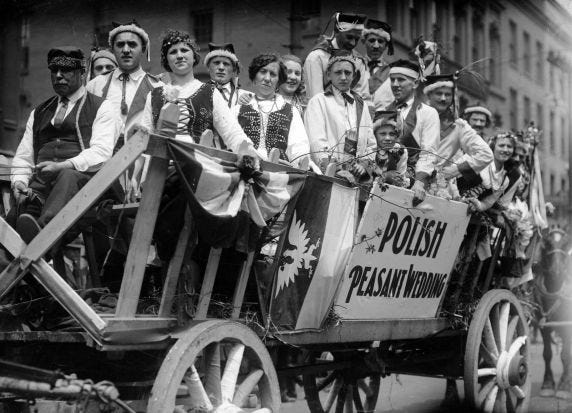
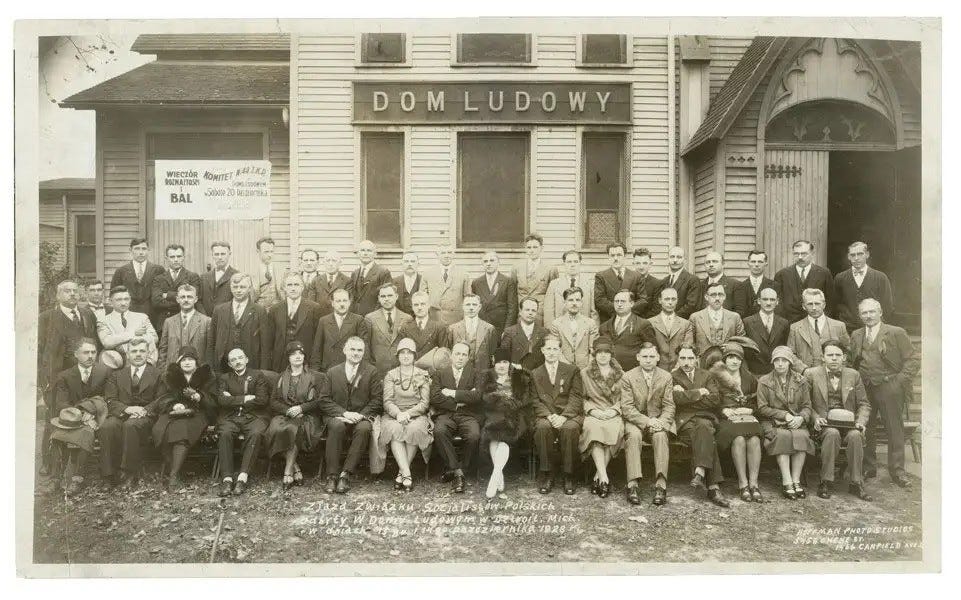
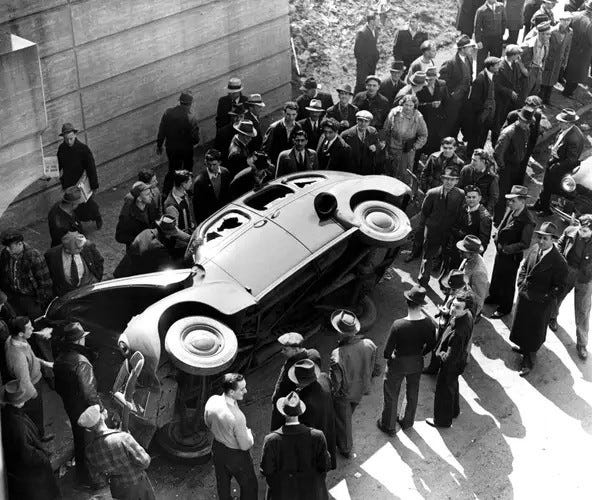
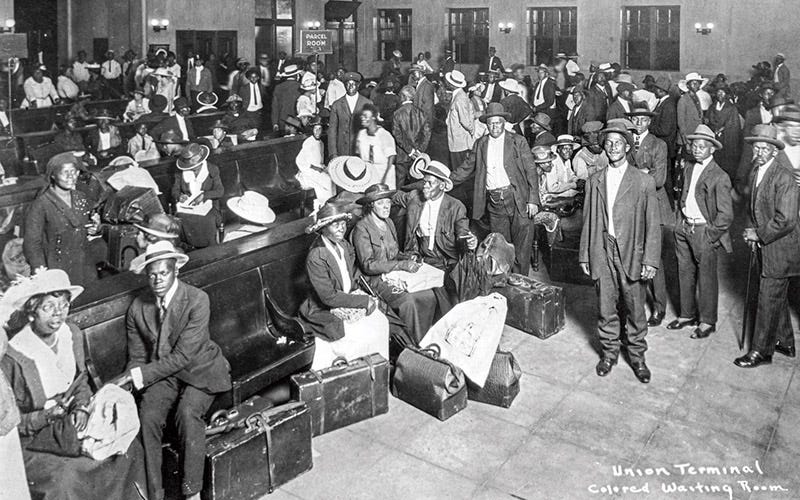
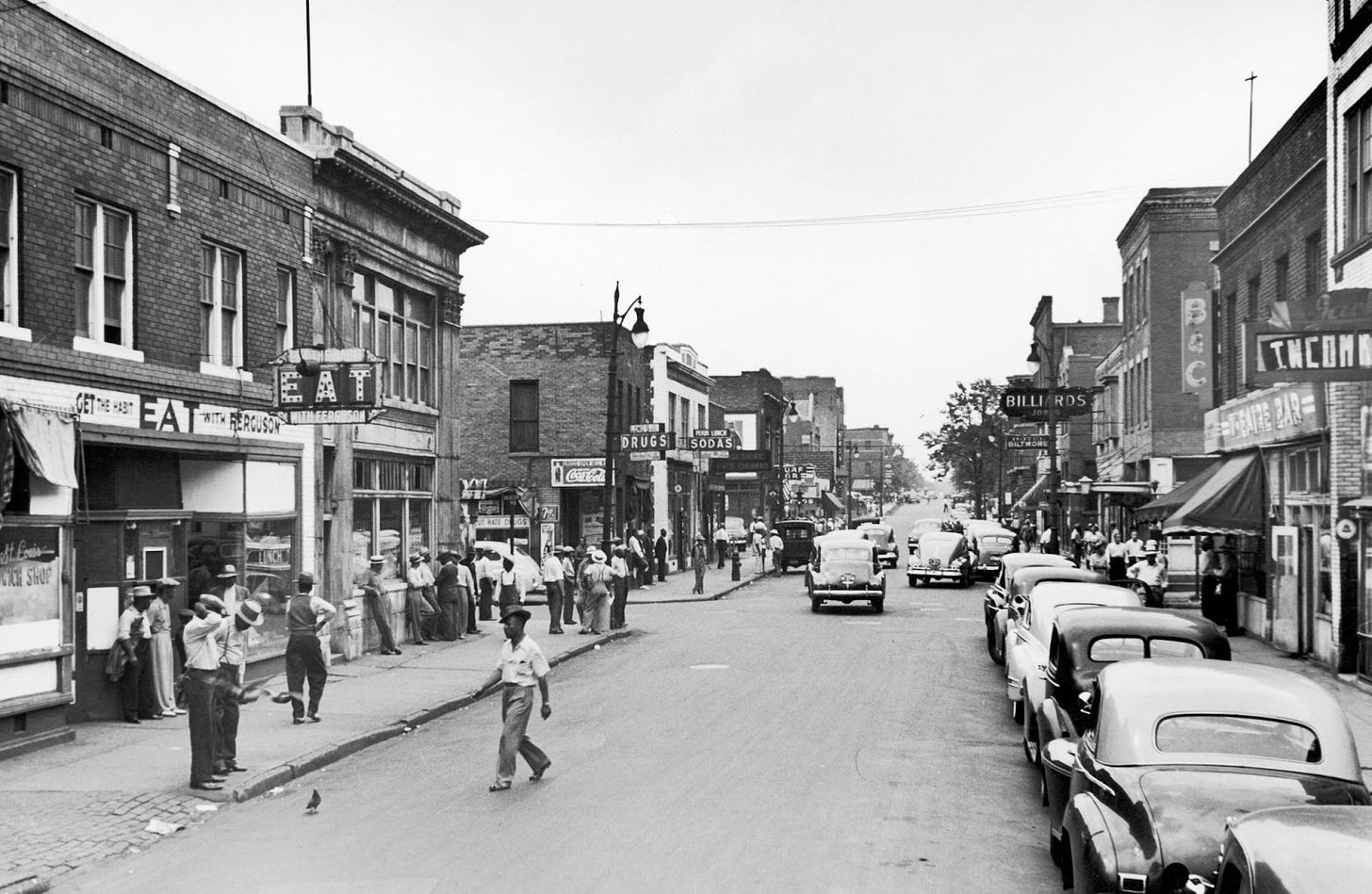
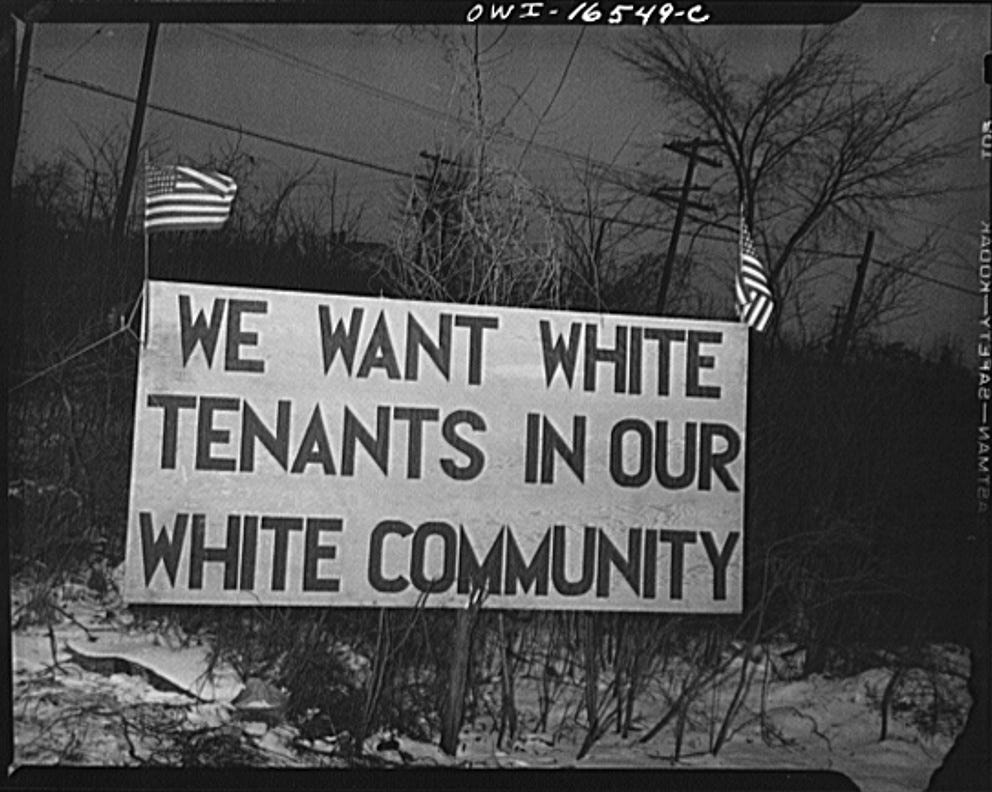
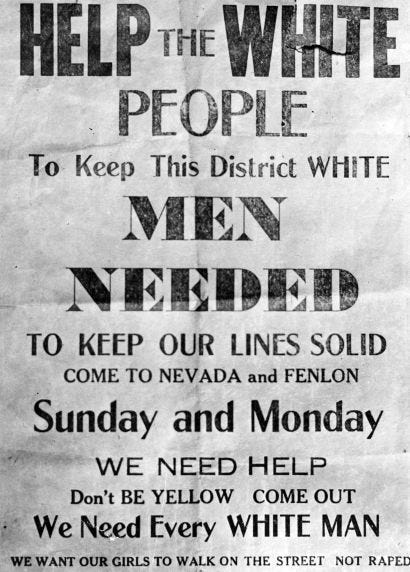
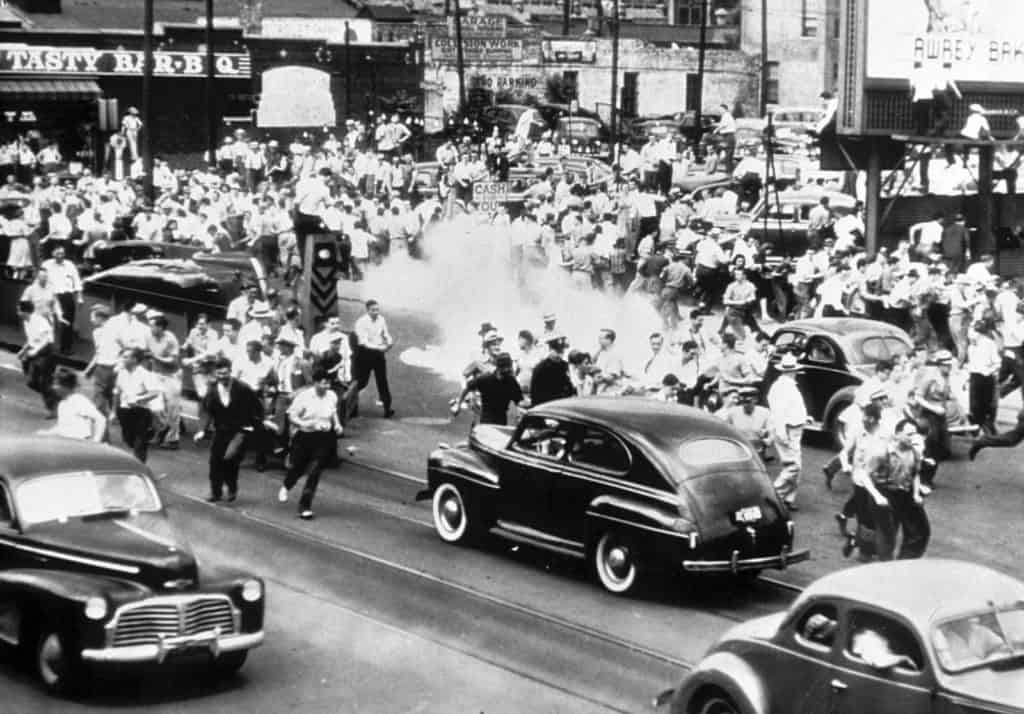
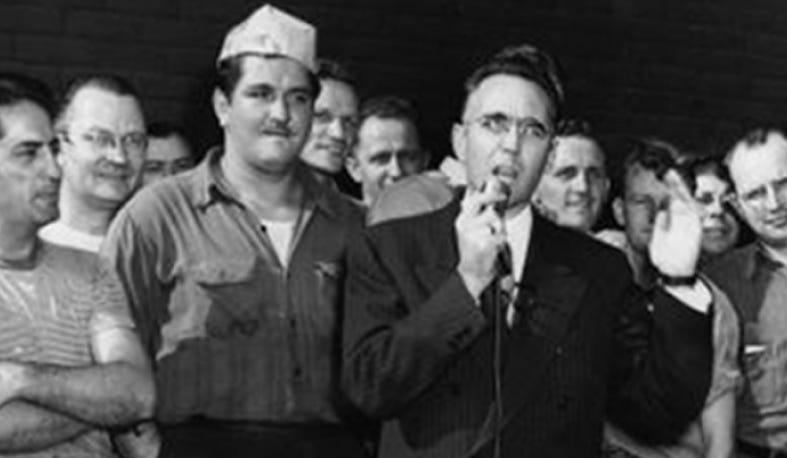
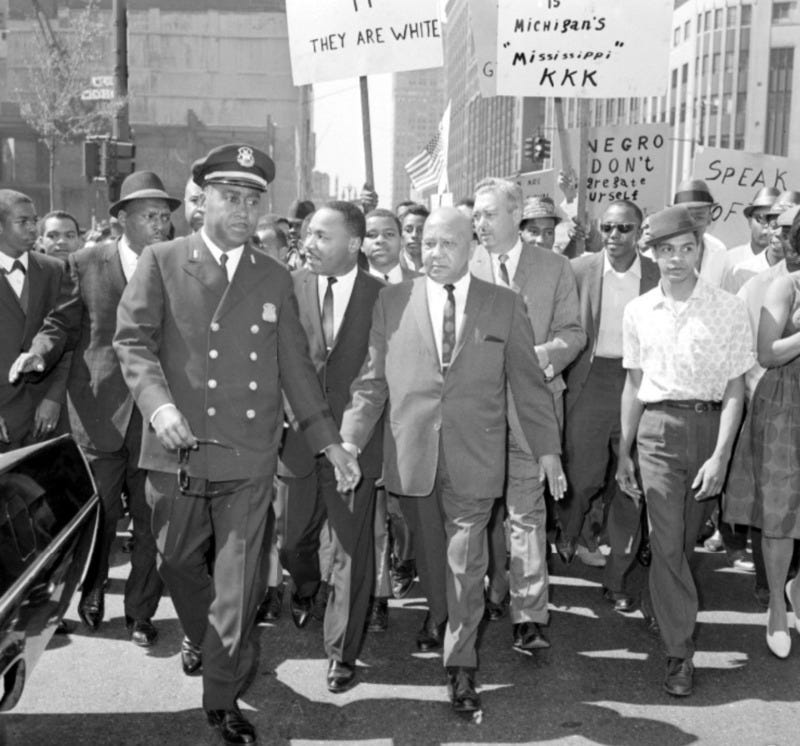
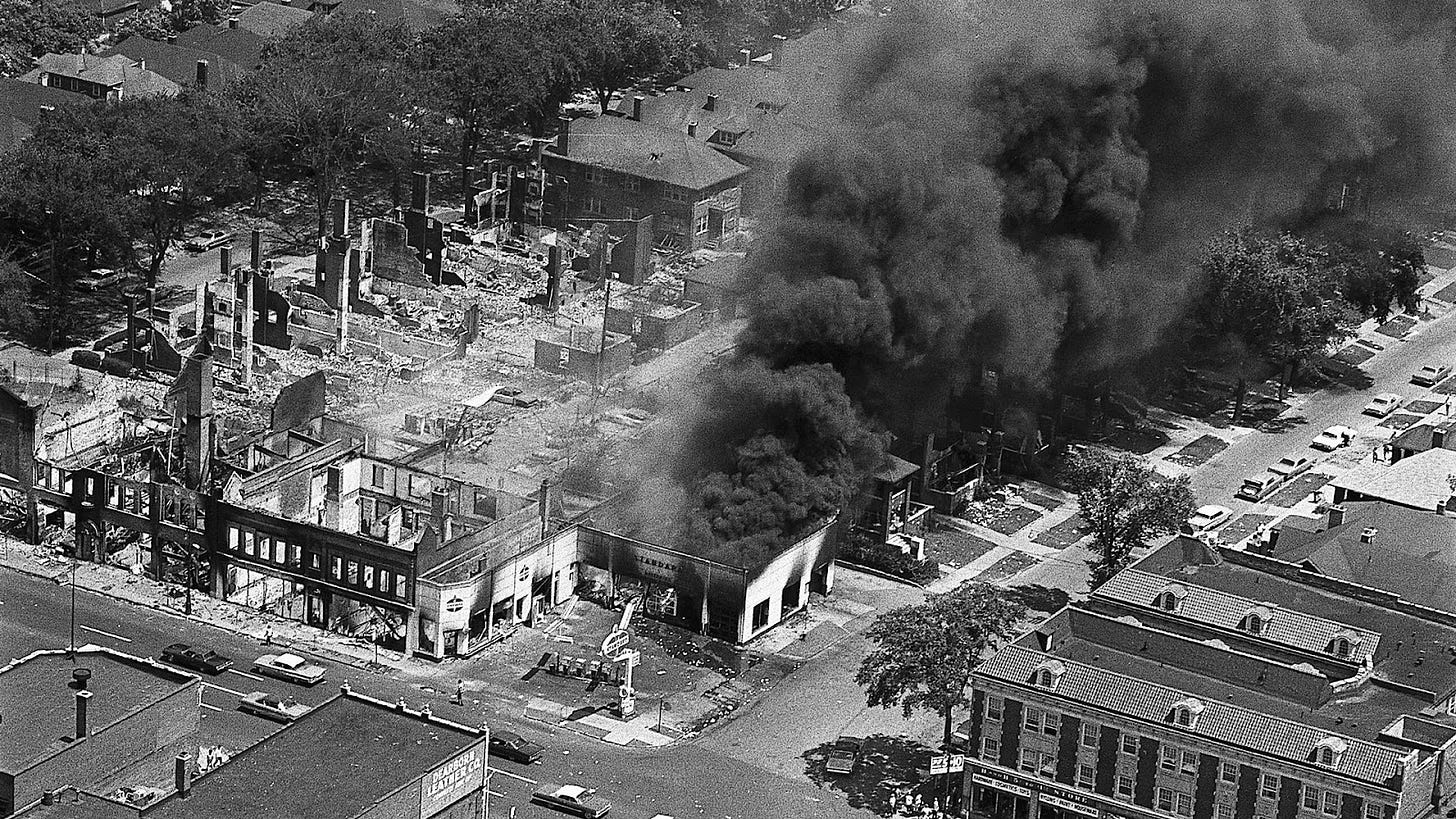
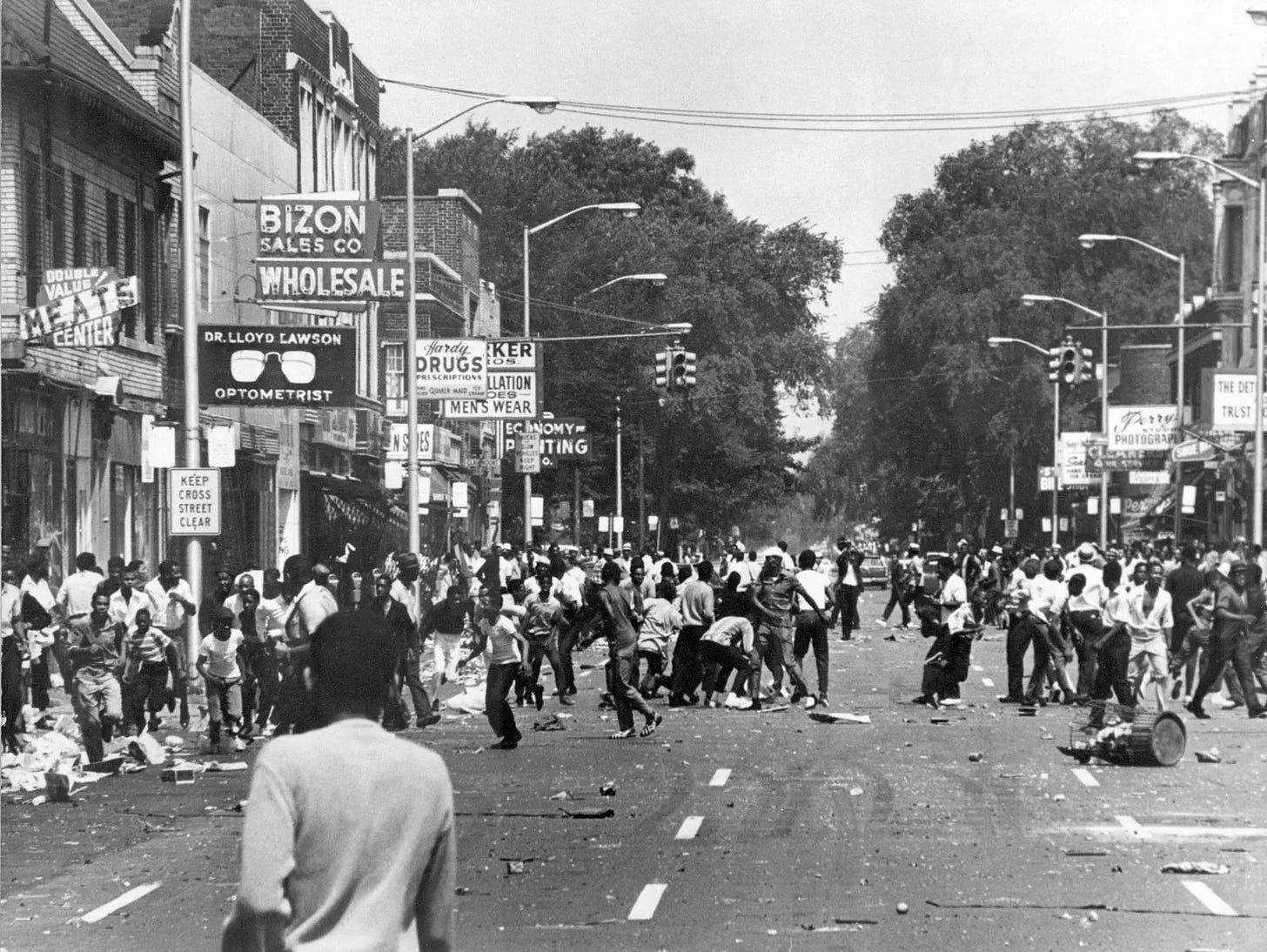
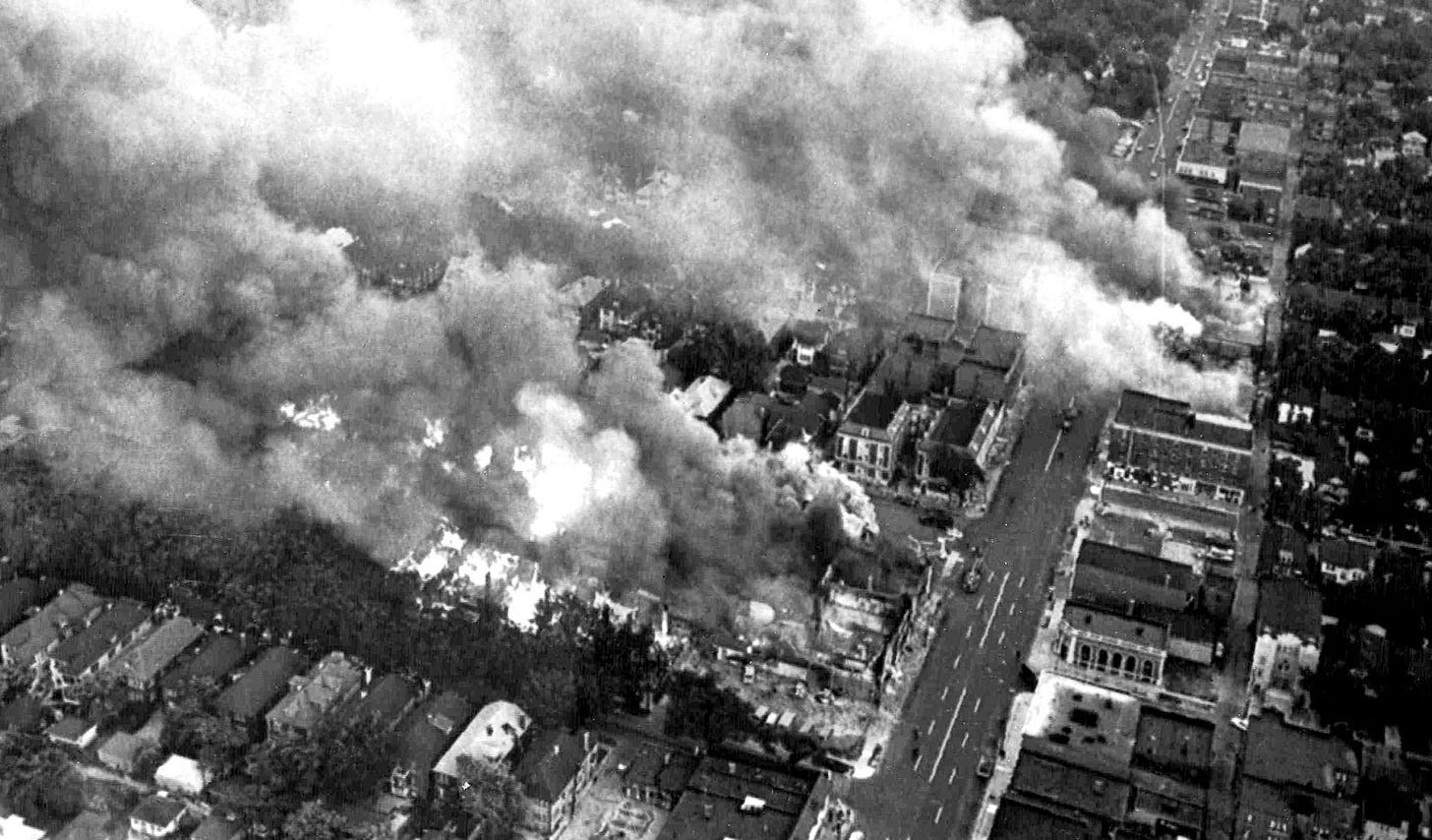

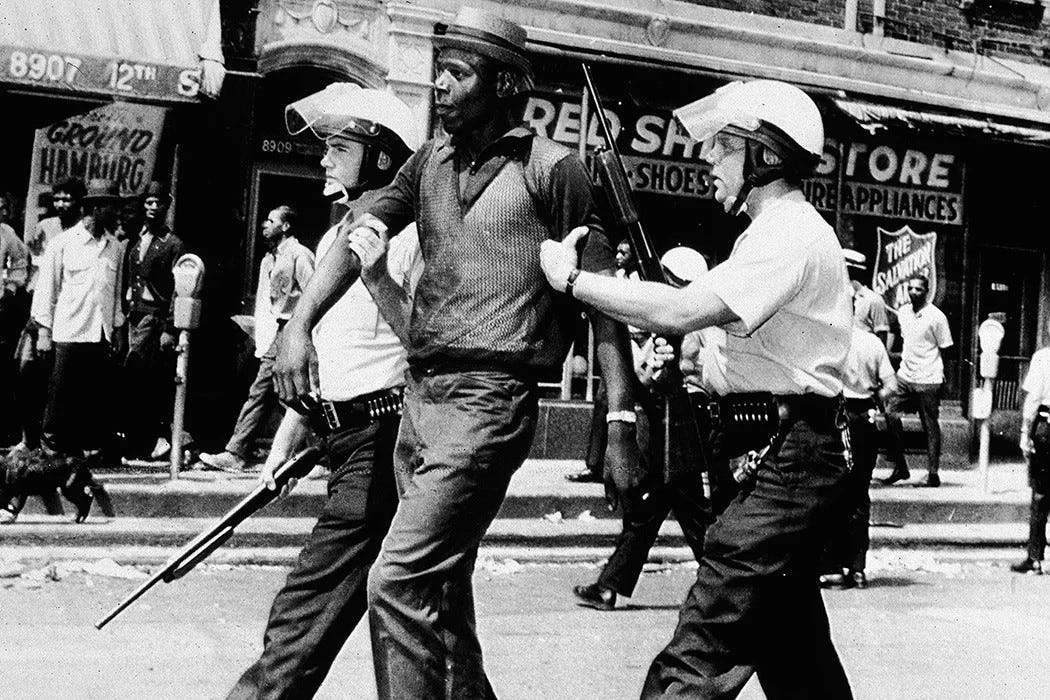
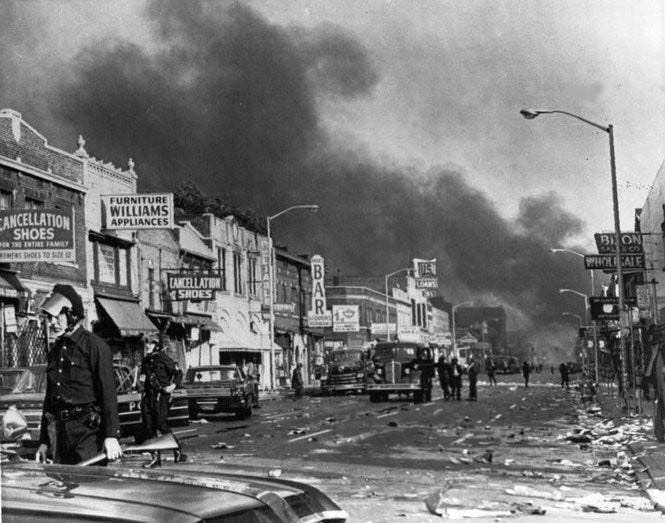
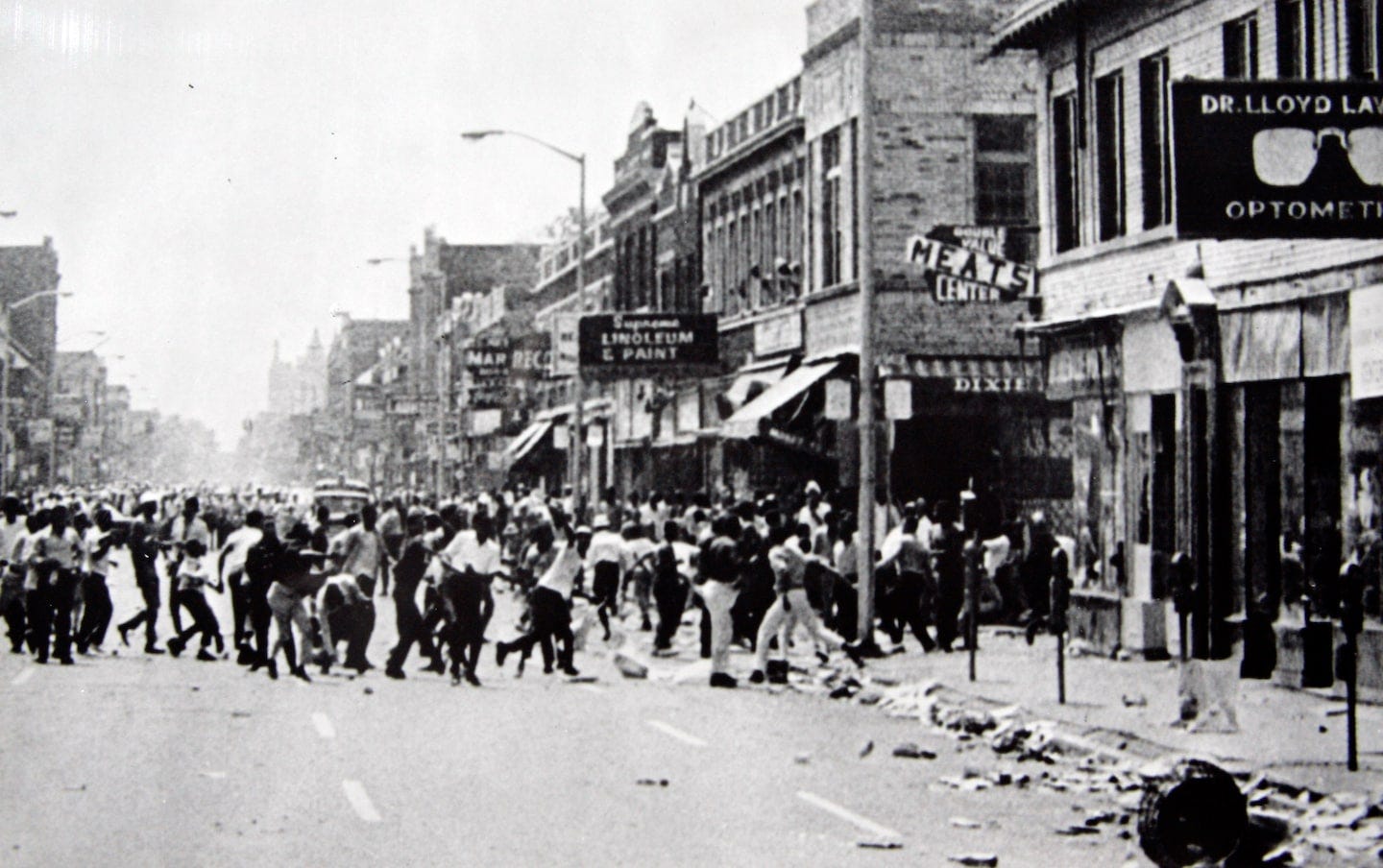
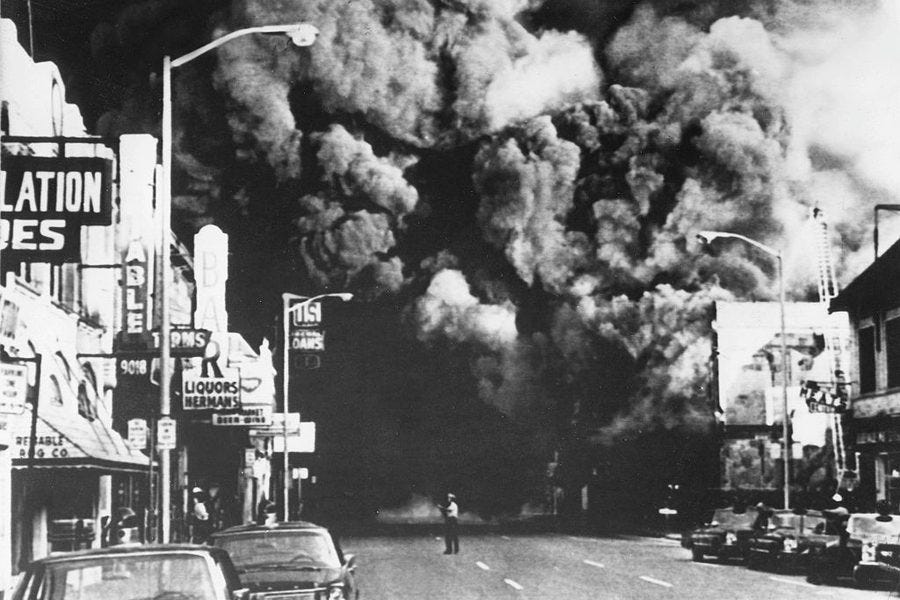
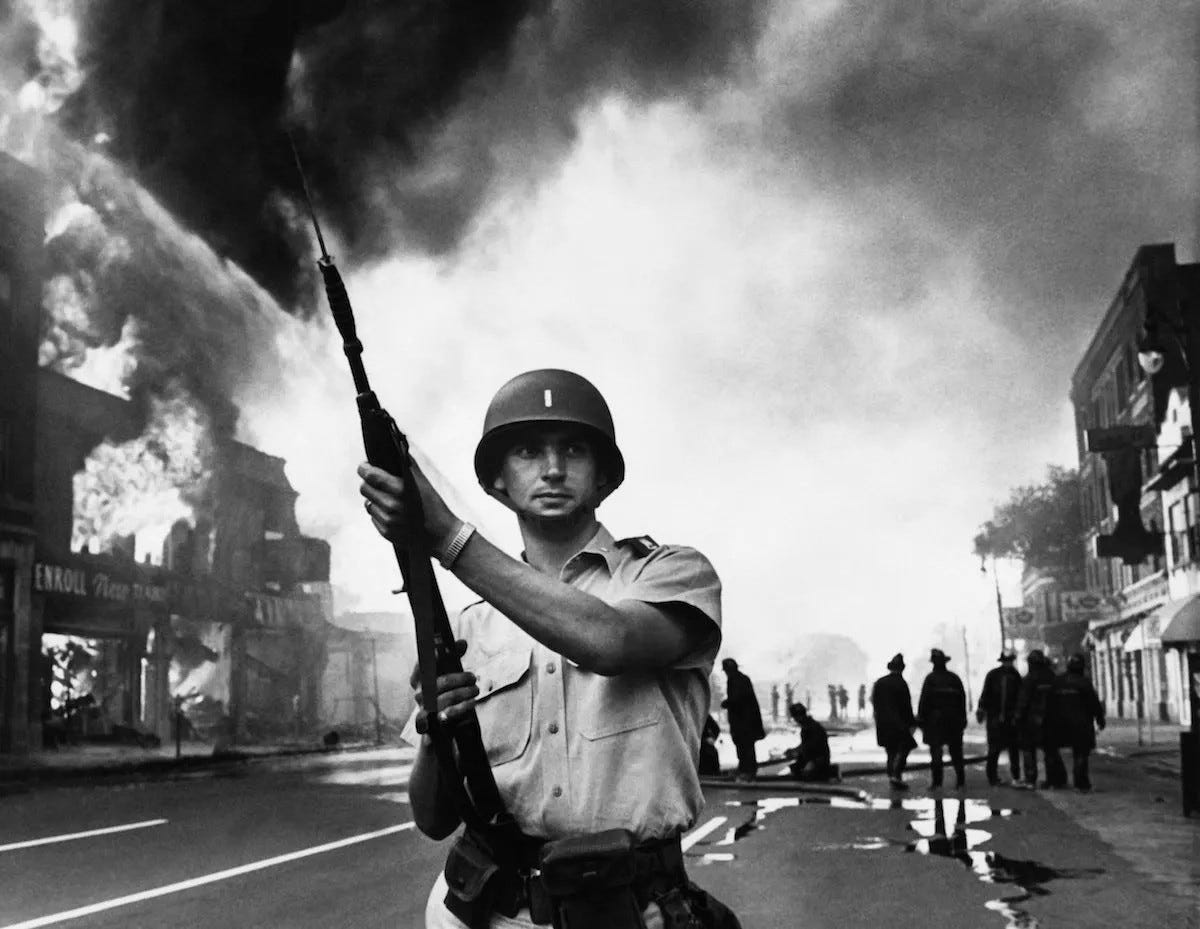
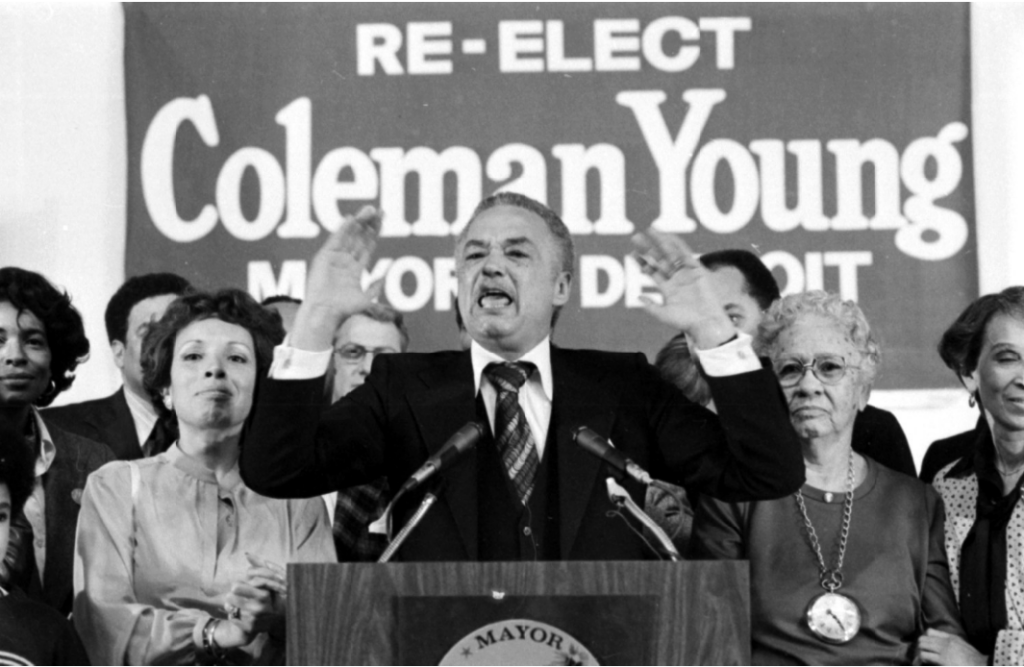
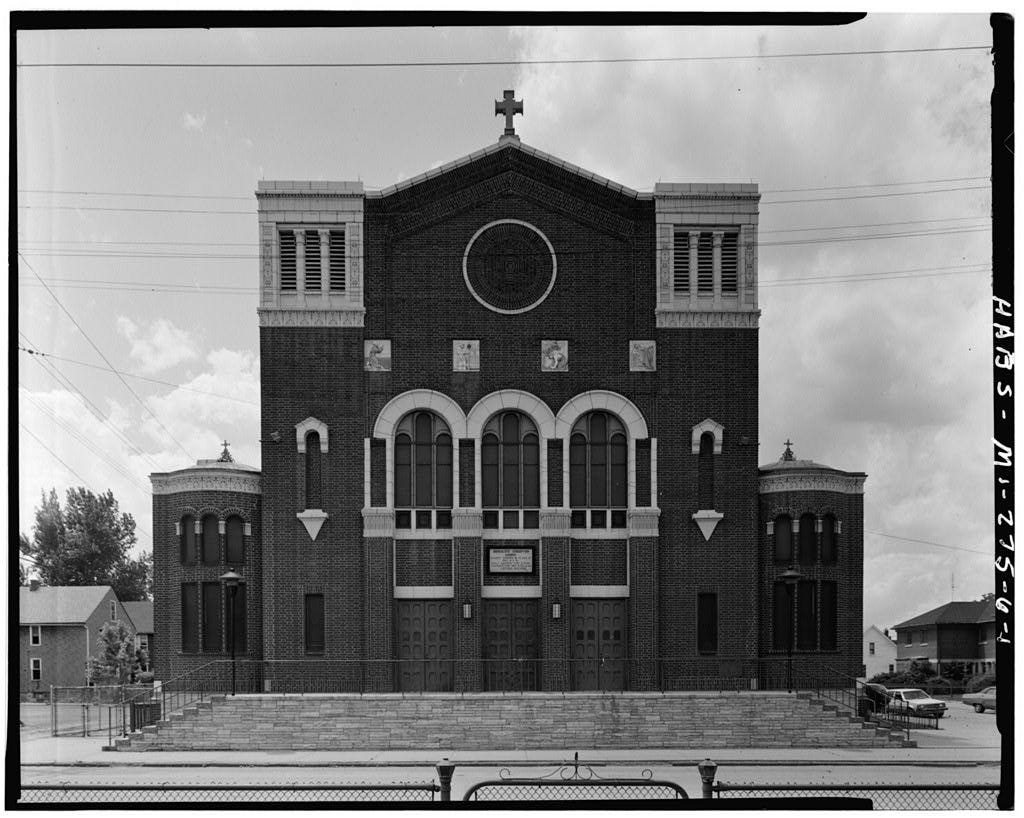
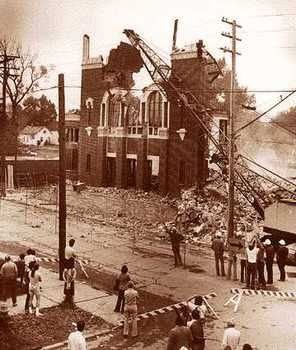
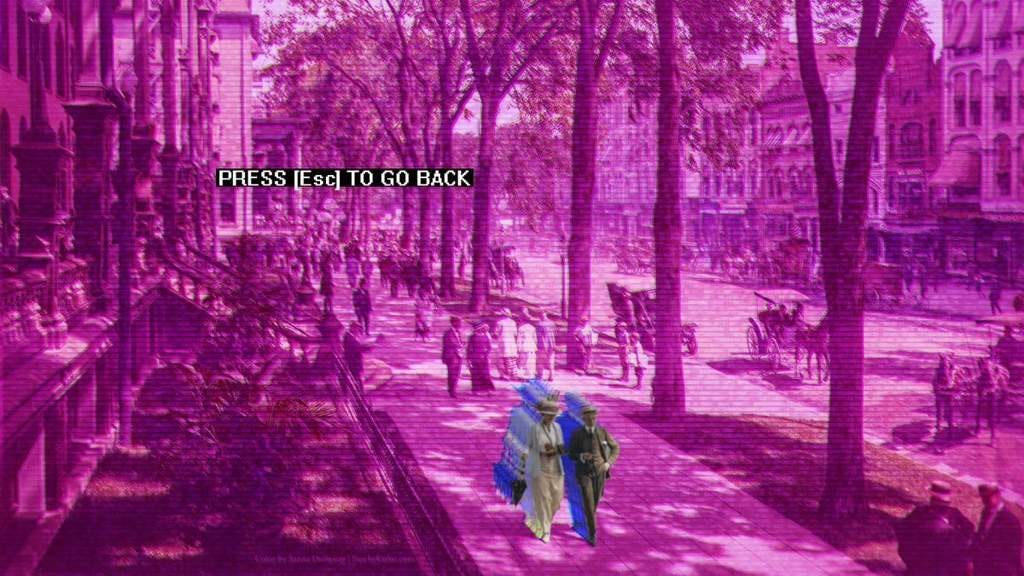

This same infiltration happened in my home town, Toronto. I had already left in the early 70's, but my family remained.
When they finally left in the early 80's it was explained to me to be 'white flight.' Most of my clan moved north to the Georgian Bay area.
I can see now how our society was destroyed by social engineering and why.
It's like the frog in the pot of water analogy and it's all for control of power and money. 'They' got us good!
Tell me again, immigration is not being used as a weapon of war to turn all of North America into a 3rd world cartel/gang ruled ghetto?